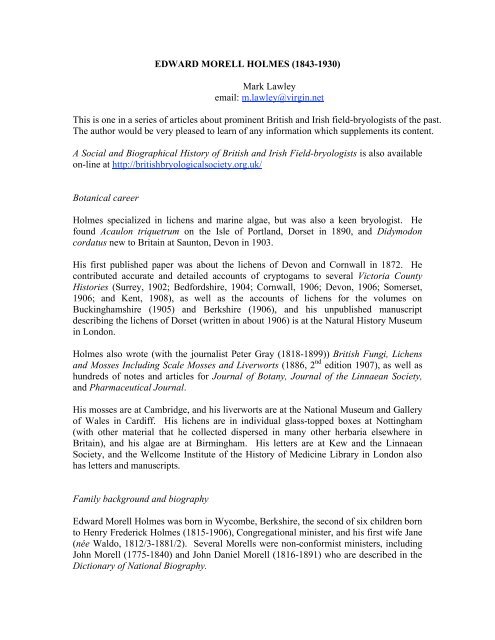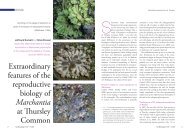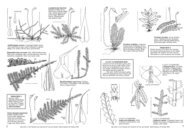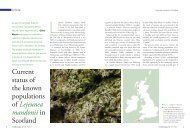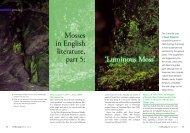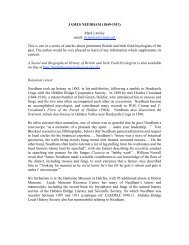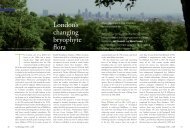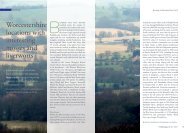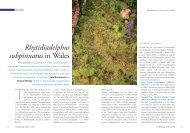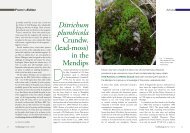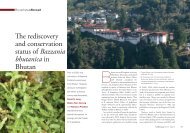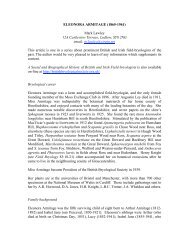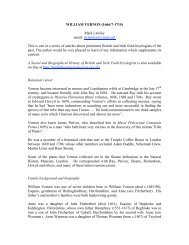EDWARD MORELL HOLMES (1843-1930) Mark Lawley email: m ...
EDWARD MORELL HOLMES (1843-1930) Mark Lawley email: m ...
EDWARD MORELL HOLMES (1843-1930) Mark Lawley email: m ...
Create successful ePaper yourself
Turn your PDF publications into a flip-book with our unique Google optimized e-Paper software.
<strong>EDWARD</strong> <strong>MORELL</strong> <strong>HOLMES</strong> (<strong>1843</strong>-<strong>1930</strong>)<br />
<strong>Mark</strong> <strong>Lawley</strong><br />
<strong>email</strong>: m.lawley@virgin.net<br />
This is one in a series of articles about prominent British and Irish field-bryologists of the past.<br />
The author would be very pleased to learn of any information which supplements its content.<br />
A Social and Biographical History of British and Irish Field-bryologists is also available<br />
on-line at http://britishbryologicalsociety.org.uk/<br />
Botanical career<br />
Holmes specialized in lichens and marine algae, but was also a keen bryologist. He<br />
found Acaulon triquetrum on the Isle of Portland, Dorset in 1890, and Didymodon<br />
cordatus new to Britain at Saunton, Devon in 1903.<br />
His first published paper was about the lichens of Devon and Cornwall in 1872. He<br />
contributed accurate and detailed accounts of cryptogams to several Victoria County<br />
Histories (Surrey, 1902; Bedfordshire, 1904; Cornwall, 1906; Devon, 1906; Somerset,<br />
1906; and Kent, 1908), as well as the accounts of lichens for the volumes on<br />
Buckinghamshire (1905) and Berkshire (1906), and his unpublished manuscript<br />
describing the lichens of Dorset (written in about 1906) is at the Natural History Museum<br />
in London.<br />
Holmes also wrote (with the journalist Peter Gray (1818-1899)) British Fungi, Lichens<br />
and Mosses Including Scale Mosses and Liverworts (1886, 2 nd edition 1907), as well as<br />
hundreds of notes and articles for Journal of Botany, Journal of the Linnaean Society,<br />
and Pharmaceutical Journal.<br />
His mosses are at Cambridge, and his liverworts are at the National Museum and Gallery<br />
of Wales in Cardiff. His lichens are in individual glass-topped boxes at Nottingham<br />
(with other material that he collected dispersed in many other herbaria elsewhere in<br />
Britain), and his algae are at Birmingham. His letters are at Kew and the Linnaean<br />
Society, and the Wellcome Institute of the History of Medicine Library in London also<br />
has letters and manuscripts.<br />
Family background and biography<br />
Edward Morell Holmes was born in Wycombe, Berkshire, the second of six children born<br />
to Henry Frederick Holmes (1815-1906), Congregational minister, and his first wife Jane<br />
(née Waldo, 1812/3-1881/2). Several Morells were non-conformist ministers, including<br />
John Morell (1775-1840) and John Daniel Morell (1816-1891) who are described in the<br />
Dictionary of National Biography.
Henry Frederick Holmes was born in Stoke Newington, Middlesex; Jane Waldo was born<br />
in Burriton, Hampshire. They married in Hackney in 1840, and their first child, Henry<br />
Robert Oliver, was born in Wendover, Buckinghamshire in 1841. At the time of the 1841<br />
census Henry and Jane were living in Pound Street, Wendover, but by 1851 had moved to<br />
Cavendish Villa, near Aylesbury Road, Wendover. After Edward arrived in <strong>1843</strong>, Alfred<br />
Reginald was born in 1846, Ernest Oliver in 1847, Serena Jane in 1850, and Emma<br />
Louisa in 1854. All the children were born in Wendover, except Emma who was born in<br />
Boston, Lincolnshire.<br />
By 1861, Edward was living with (and presumably an assistant to) Thomas Vicary, a<br />
chemist in Plymouth. Holmes registered as a pharmaceutical chemist in December 1862,<br />
and was still in Plymouth, working as a chemist in 1871. However, in 1872 he became<br />
curator of the Pharmaceutical Society’s museum at 17, Bloomsbury Square, London, a<br />
post that he held for fifty years until 1922. Between 1873 and 1876 Holmes also lectured<br />
in botany at the Westminster Hospital School, and from 1887 until 1890 he was Lecturer<br />
in Materia Medica at the Pharmaceutical Society.<br />
In 1881 Holmes was living at 30, Arthur Road, Islington, Finsbury, London with his<br />
younger sister Emma, but in 1882 he married Catherine Appleford (born 1841/2),<br />
daughter of Frederick Joshua Appleford (1816-1882), clerk to an East India merchant in<br />
1851, and Eleanor (née Thompson 1818/23-1885). They had no children. In 1891 the<br />
couple were living at Bradbourne Dene, Bradbourne Road, Sevenoaks, Kent; by 1901<br />
they had moved to Rushorn, Virie Court, Sevenoaks.<br />
Holmes was “a rapid and indefatigable walker, his quick sight detecting plants as he was<br />
racing along at five miles an hour”, but in 1921 he was knocked down by a car, and had<br />
to have part of one leg amputated, for which he was subsequently awarded £1,000 in the<br />
King’s Bench Division. With his work in the field much restricted, Holmes advertised<br />
his services as a “consulting botanist and pharmacognosist” from his home at Sevenoaks,<br />
where he was “open to give expert botanical assistance, on business terms, to merchants<br />
and others”. The Pharmaceutical Society retained Holmes as Emeritus Curator of their<br />
museum from 1922 until his death.<br />
Edward Holmes died in Sevenoaks on September 10 th <strong>1930</strong>.


